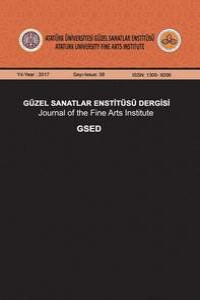Abstract
Postmodern art movements
primarily began in America and some European countries in the 1960s as a result
of the process whereby the artist, an individual in the first place, having
been affected by the great social events of the day, began to reflect his
personal ideas in his works. The object of art, having gone through many
changes in the history of art, is considered together with place as sculpture
combined with place and the painting freed itself from flat surface in the
postmodern era. In this respect, concept of place is aimed to analyze in
different perspectives and its relation with the art object is made clear with
examples. The two Turkish artists considered in this study are Hale Tenger and
Ayşe Erkmen. Both artists used place as the primary element in their works, but
they utilize the space by the means of fictioning as to the new context. In
these contexts, Erkmen mentioned the sociological issues by the public spaces
turning into the art objects and benefited from the sociologic historical
informations. On the other hand Tenger gained advantage individual historical
informations, controversies like male-female, death-life and inside-outside,
preferred to attract and make the people shock by the way of using odour,
lightness and motion of the space and adding these effects to the head meaning.
Keywords
References
- Akay A. (2010). Birleşmeyen Sentez. İstanbul: Yapı Kredi Yayınları.
- Antmen A. (2007). Hale Tenger: İçerdeki Yabancı. İstanbul: Yapı Kredi Yayınları.
- Antmen A. (2007 A). Hale Tenger ile Söyleşi (ek). İstanbul: Yapı Kredi Yayınları.
- Atakan N. (1998). Arayışlar: Resimde ve Heykelde Alternatif Akımlar. İstanbul: Yapı Kredi Yayınları.
- Danto C. A. (2010). Sanatın Sonundan Sonra: Çağdaş Sanat ve Tarihin Sınır Çizgisi. (Çeviren:Zeynep Demirsü). İstanbul:Ayrıntı Yayınları.
- Dedeal H. (2008). Seksenlerde Türkiye’de Çağdaş sanat: Yeni Açılımlar. “Ayşe Erkmen”. (Editörler: İpek Duben ve Esra Yıldız). İstanbul: İstanbul Bilgi Üniversitesi Yayınları.
- Duben İ. (2008). Seksenlerde Türkiye’de Çağdaş sanat: Yeni Açılımlar. (Editörler: İpek Duben ve Esra Yıldız). İstanbul: İstanbul Bilgi Üniversitesi Yayınları.
- Gintz C. (2010). Başka Yerde Başka Biçimde. (Çeviren: Muna Cedden). Ankara: Dost Yayınevi.
- İstanbul Modern Sanat Müzesi Kataloğu, Yeni Yapıtlar Yeni Ufuklar Sergi Kataloğu (2009-2010), Ayşe Erkmen’in Mayınlar Serisi.
- Madra B. (2003). İki Yılda Bir Sanat: Bienal Yazıları (1987-2003). İstanbul: Norgunk Yayıncılık.
- Rıfat M. (2008). Yaklaşımlarıyla Eleştiri Kuramcıları. (2. bs.) İstanbul: Sel Yayıncılık.
- Sönmez N. (2006). Sanat Hayatı İçerir Mi? (Sergi Eleştirileri 1987-2000). İstanbul: Yapı Kredi Yayınları.
- Şaylan G. (2009). Postmodernizm. (4. bs.). Ankara: İmge Kitabevi.
- Tanyeli U., İleri C., Karamustafa G. (2000). Kent:Hazır-yapıt. Sanat Dünyamız. S.78. İstanbul: Yapı Kredi Yayınları.
Abstract
Postmodern
sanat hareketleri, öncelikle bir birey olan sanatçının, çeşitli büyük toplumsal
olaylardan doğrudan etkilenmesi sonucu bazı kişisel fikirlerini, sanat yapıtına
yansıtması nedeniyle 1960’larda Amerika’da ve bazı Avrupa ülkelerinde
başlamıştır. Tüm sanat tarihi anlatısı boyunca değişime uğrayan sanat nesnesi,
postmodern dönemde heykelin mekâna yayılması ve resmin yassı yüzeyinden çıkması
gibi nedenlerle mekanla birlikte düşünülmektedir. Bu bağlamda, mekân kavramı
farklı yönleriyle irdelenmiş ve sanat nesnesiyle ilişkisini örnekler yoluyla
ortaya çıkarabilmek amaçlanmıştır. Ele alınan iki Türk sanatçı Hale Tenger ve
Ayşe Erkmen, dönemin sanat anlayışlarını yansıttıklarından tercih edilmiştir. Her iki sanatçı da sanat işlerinde öncelikli
eleman olarak mekânı yeni bir bağlamda kurgulayarak kullanmışlardır. Bu kurgularda
Erkmen, kamu alanlarını sanat nesnesine dönüştürerek toplumsal konuları ele
almış ve toplumsal tarihin verilerinden faydalanmıştır. Bunun yanında Tenger,
mekan kurgularında öznel tarih verilerinden, kadın-erkek, ölüm-yaşam ve içerisi-dışarısı
gibi karşıtlıklardan yararlanmış ve mekanın koku, ışık ve hareket gibi çeşitli
boyutlarını da anlam oluşturma süreçlerine katarak, izleyeni şok etme yoluna
gitmiştir.
Keywords
References
- Akay A. (2010). Birleşmeyen Sentez. İstanbul: Yapı Kredi Yayınları.
- Antmen A. (2007). Hale Tenger: İçerdeki Yabancı. İstanbul: Yapı Kredi Yayınları.
- Antmen A. (2007 A). Hale Tenger ile Söyleşi (ek). İstanbul: Yapı Kredi Yayınları.
- Atakan N. (1998). Arayışlar: Resimde ve Heykelde Alternatif Akımlar. İstanbul: Yapı Kredi Yayınları.
- Danto C. A. (2010). Sanatın Sonundan Sonra: Çağdaş Sanat ve Tarihin Sınır Çizgisi. (Çeviren:Zeynep Demirsü). İstanbul:Ayrıntı Yayınları.
- Dedeal H. (2008). Seksenlerde Türkiye’de Çağdaş sanat: Yeni Açılımlar. “Ayşe Erkmen”. (Editörler: İpek Duben ve Esra Yıldız). İstanbul: İstanbul Bilgi Üniversitesi Yayınları.
- Duben İ. (2008). Seksenlerde Türkiye’de Çağdaş sanat: Yeni Açılımlar. (Editörler: İpek Duben ve Esra Yıldız). İstanbul: İstanbul Bilgi Üniversitesi Yayınları.
- Gintz C. (2010). Başka Yerde Başka Biçimde. (Çeviren: Muna Cedden). Ankara: Dost Yayınevi.
- İstanbul Modern Sanat Müzesi Kataloğu, Yeni Yapıtlar Yeni Ufuklar Sergi Kataloğu (2009-2010), Ayşe Erkmen’in Mayınlar Serisi.
- Madra B. (2003). İki Yılda Bir Sanat: Bienal Yazıları (1987-2003). İstanbul: Norgunk Yayıncılık.
- Rıfat M. (2008). Yaklaşımlarıyla Eleştiri Kuramcıları. (2. bs.) İstanbul: Sel Yayıncılık.
- Sönmez N. (2006). Sanat Hayatı İçerir Mi? (Sergi Eleştirileri 1987-2000). İstanbul: Yapı Kredi Yayınları.
- Şaylan G. (2009). Postmodernizm. (4. bs.). Ankara: İmge Kitabevi.
- Tanyeli U., İleri C., Karamustafa G. (2000). Kent:Hazır-yapıt. Sanat Dünyamız. S.78. İstanbul: Yapı Kredi Yayınları.
Details
| Journal Section | Articles |
|---|---|
| Authors | |
| Publication Date | May 29, 2017 |
| Submission Date | April 6, 2017 |
| Published in Issue | Year 2017 Issue: 38 |
Obtaining permissions for studies requiring ethics committee approval regarding the implementation of ethical rules and including information about permission in the article was added to the criteria. In this direction, Ethics Committee Permission is required for articles submitted to our journal and meeting the conditions stated below.
• Any research conducted with qualitative or quantitative approaches that require data collection from participants using questionnaires, interviews, focus group work, observation, experimentation, and interview techniques.
Also;
• Obtaining and indicating permission from the owners for the use of scales, surveys and photographs belonging to others,
• It should be stated that the copyright regulations are complied with for the intellectual and artistic works used.


